
The film Captain Phillips follows the hijacking of an American boat and kidnapping of its Captain by Somali men, so-called pirates. It is the visualisation of the biography of the kidnapped Captain Richard Phillips. The images and scenes which are presented constantly contrast between the life and actions of the American crew versus the Somali crew. This discussion will outline the misrepresentations and generalisations of the Somalis in this film and how Somalia is viewed and referred to in opposition to the US and the West. Therefore, this discussion will showcase through three layers of Critical Discourse Analysis (CDA) how Captain Phillips exhibits a distorted view of Somalis within the film and as subordinate in the domineering relationship with the United States (US) and the West. Through this analysis, we will argue that the film Captain Phillips misrepresents and generalises the Somali people as criminal ‘pirates’ and continues a distorted unequal view of the relations between Somalia and America and the West in the discourse. We will begin with explaining why we chose this film for our analysis. We will then continue with describing our conceptual framework and methodology. Moreover, our analysis of the film is presented in three layers of CDA.

Why Captain Phillips?
Captain Phillips was chosen to investigate the discourse behind the portrayal of Somali ‘pirates’ in Western media. This film was released in 2013 and was a box-office hit, with a profit of around $220 million and 6 Oscars nominations (Internet Movie Database [IMDb], 2013). The ability of films to shape public discussion and influence news sources demonstrates the importance that this form of popular culture has on perceptions. “In particular, narrative forms—including books, television shows, and movies—have an incredible ability to influence the images and perceptions of individuals and society in general about numerous topics” (Pautz, 2016, p.250). One can thus consider the potential of Captain Phillips to have a significant impact on the public opinion concerning Somali ‘pirates’. Exploring IMDb's brief description of the film, they outline the film as a (crime) thriller as well as a “multi-layered examination” of a true story. Hence the need to explore the representations demonstrated and how it is situated in the global socio-political discourse to fundamentally explore the extent to which it is truly “multi-layered”.
The story of Captain Phillips is based on the real-life events of captain Richard Phillips, who documented his experiences in his memoir A Captain's Duty: Somali Pirates, Navy SEALs, and Dangerous Days at Sea (Danoff, 2017).
The film demonstrates how the crew of the MAERSK Alabama container ship encounter four Somali ‘pirates’ during their journey around the Horn of Africa. The ship is hijacked by the pirates, who are unsatisfied with both the value of the cargo and the amount of money that is present. The situation escalates when Captain Phillips is abducted by the pirates leaving the ‘Alabama’ using one of her lifeboats. The US Naval forces and military arrive and end up executing three of the pirates, and imprisoning the remaining pirate. Captain Phillips is saved and celebrated as a hero.

‘Pirates’
It must be stated that this analysis and discussion is presented by two White European students who have never visited Somalia. Therefore, the perspective of this analysis is essentially based upon a Western-centric knowledge base of European education and thus may potentially continue a Western-biased discussion of Somalis, ‘Africa’ and ‘piracy’.Throughout this blog, the problematic words ‘pirate/s’ and ‘piracy’ will be used to ensure consistency with the film, yet this discourse itself is worthy of debate.
Discourse
This discussion explores the discourse surrounding Somali ‘pirates’ within the film and socio-political arenas. Discourse can be defined as the beliefs and narratives that underline any text, language, discussion, or speech (Harcup, 2014). The research takes into account the assumptions behind the film Captain Phillips. It considers not only the explicitly stated assumptions - as stated by the actors in the film for instance - but also the implicit ideas as well as the non-verbal cues in the film.
Critical Discourse Analysis
To investigate this discourse around the story of Captain Phillips, the method of Critical Discourse Analysis (CDA) is employed. CDA reveals power relations and narratives behind the film story (Fairclough, 2017; Munday, 2016), by visually ‘close-reading’ the film in order to discover patterns in the assumptions that are demonstrated - either verbally (by the actors) or visually (camera focus). CDA can be conducted either qualitatively or quantitatively. We have chosen a qualitative lens, as we believe this allows us a greater insight into the discourse, because many underlying assumptions are both unwritten and unsaid amongst the visual aspects of Captain Phillips.
We based our methodology on Fairclough’s Critical Discourse Analysis (2017), whose model of analysis consists of three dimensions: the textual, the discursive, and the social. More specifically, we employed Setiawan’s (2018) adapted version of Fairclough’s model, which he used to analyse the film Negeri van Oranje, by looking at the representation of gayness in it. Thus through following Setiwan’s method, we explore representations and discourse in films specifically.
First, the textual analysis aims to investigate the text linguistically, looking at the text’s structure, its grammar, and its vocabulary. According to Setiawan, these aspects are examined to respond to three things:
“the experiental value (a representation of ideology carried in the text), relational value (construction of the relation between the text producer and the consumers), and expressive value (construction of the identity of the text producers and consumers are presented in the text)” (Setiawan, 2018, p. 4)
Textual analysis in film can be used not only by looking at what is being said in the film, but also by considering non-verbal interaction between characters as well as interactions between the producer and the consumers.
Second, the discursive analysis examines the production and consumption processes of the film. In this dimension of analysis, one aims to answer questions about the producers’ aim with the film, the norms and values they tried to convey through the narrative, the choice of actors as well as the backgrounds of the producers. Additionally, when looking at the consumption process, the researcher takes into account the success of the film, film reviews, and newspaper articles. Due to the scope of this research, we are not able to consider both the production and the consumption processes of the second dimension. We will therefore mostly look at the production process by examining the producers’ backgrounds and their intentions with the film as they expressed during interviews.

Fairclough's (2017) CDA Model as Presented by Setiawan (2018)

Our own design
Finally, the social analysis places the discourse as discovered in the first two dimensions in the bigger sociocultural context outside the production process. The researcher investigates the time in which the film was produced, the public debate and opinion on the topic at this time, and the influence of political, economic, cultural and social aspects on the film (Setiawan, 2018; Fairclough, 2017)

This section will consist of an analysis of the story of the Captain Phillips film, highlighting the main patterns through three categories: America versus Somalia, the portrayal of the Somali and American captains, and the America-Somali relations.
First Dimension: Textual Analysis
America versus Somalia
There is an evident difference between the illustrations of the US and Somalia in the film. The US is portrayed as organised, powerful, and safe, whereas Somalia is framed as violent, poor and dangerous.
Safe versus Dangerous
We can already see this in the first scenes of the film when the hometowns of the American and Somali Captains are shown. The scene of the American neighbourhood shows a family house, but the Somali opening scenes shows young boys holding weapons. The American scene develops in cars driving on a highway, the American captain and his wife ‘chit-chatting’. In contrast, the scene of Somalia shows warlords entering the Somali village while shooting and shouting.

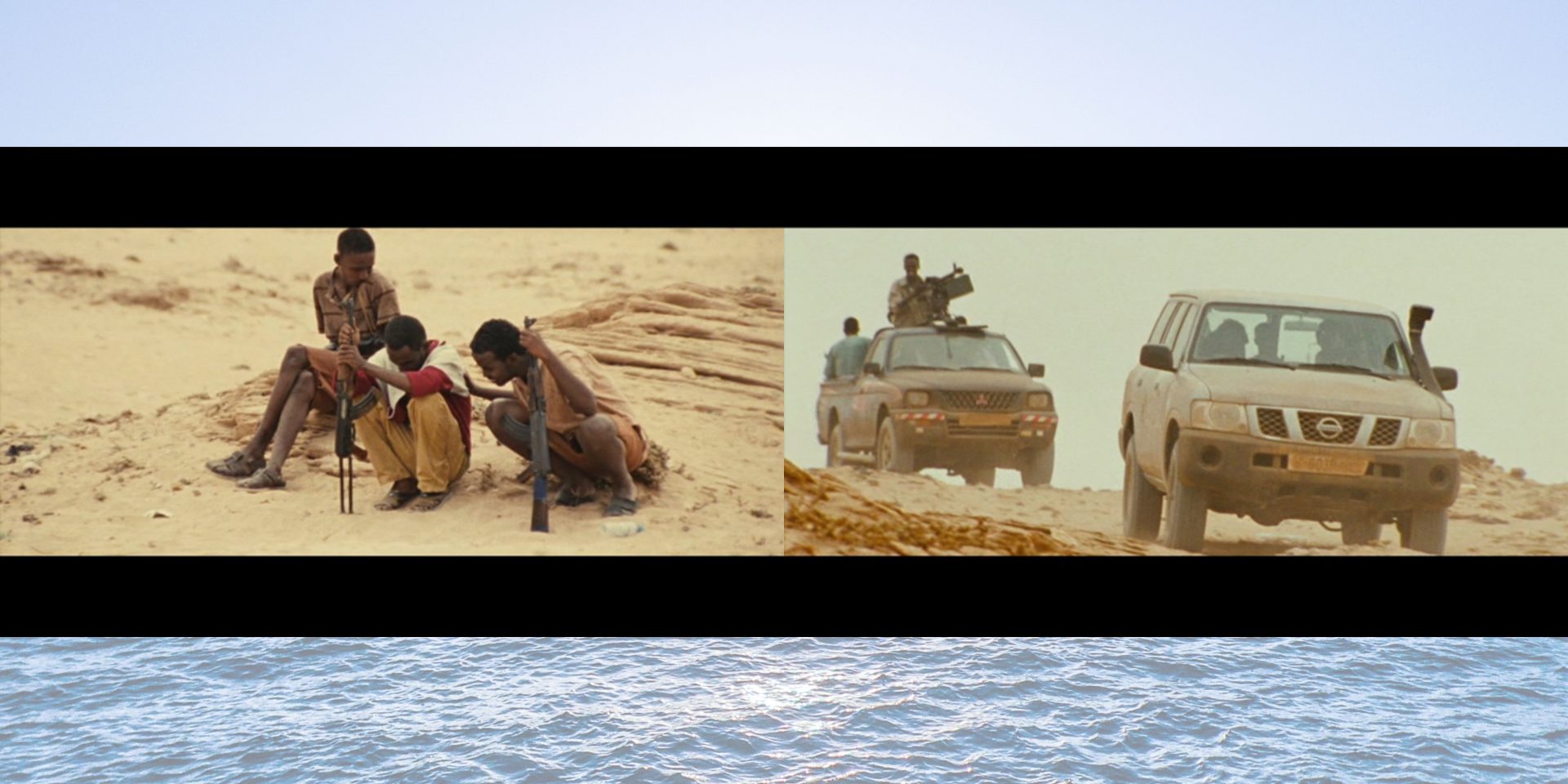
The danger of Somalia is also verbally stated by Captain Phillips when the container ship leaves on its journey. In the scene below, Phillips wants his crew to prepare for the danger of the Horn of Africa.
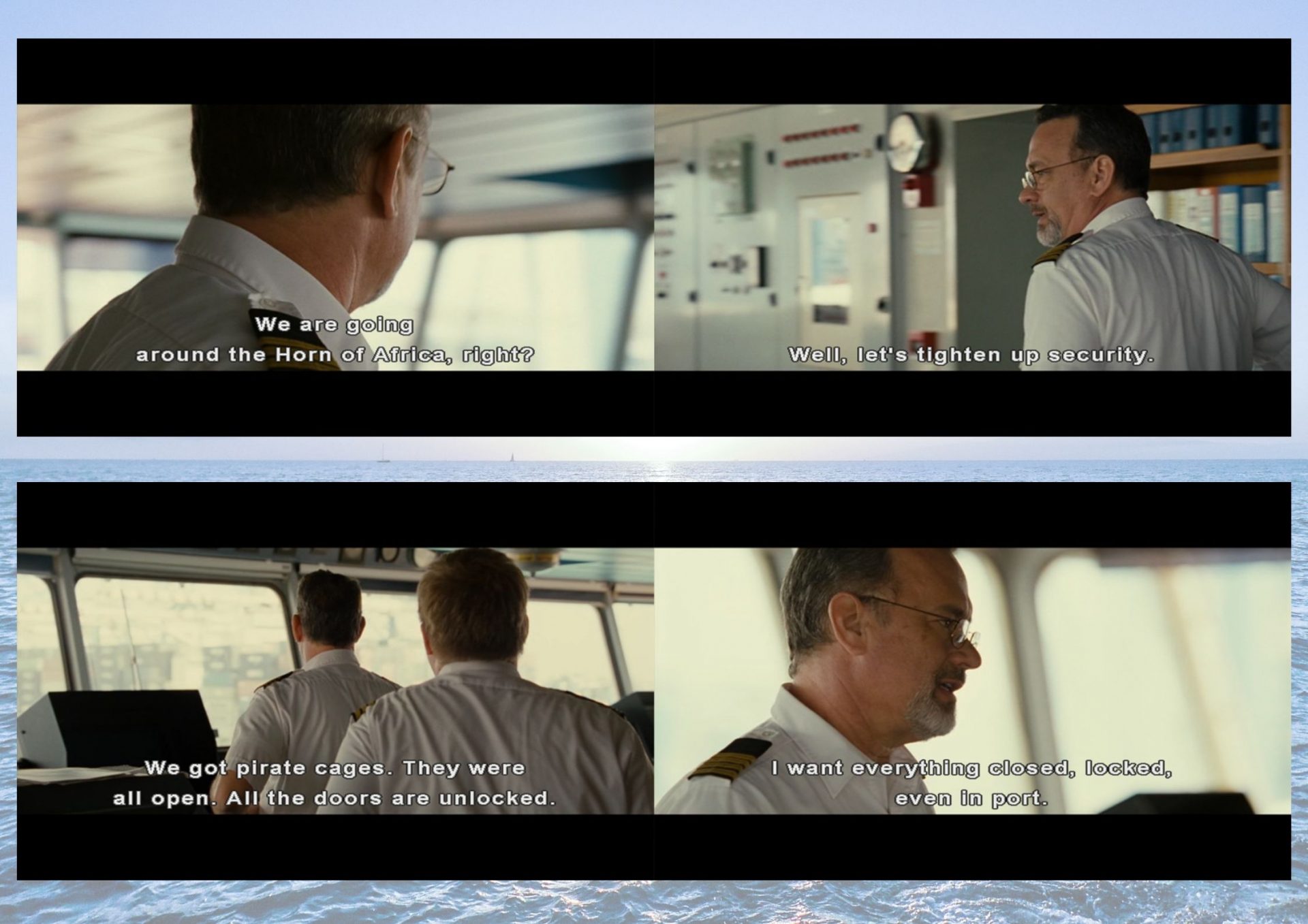
Organised versus Chaos
Another contradiction presented in the film is that America is organised and powerful, whereas Somalia is chaotic and backwards. This is evident through the organisation and sophistication of the crew. On the American ship, every crew member knows what to do and they have modern technologies available. Meanwhile, the Somali crew is quickly created through a random selection process where the men shout and barter for a place in the crew. Additionally, the Somali crew only have an old boat and broken engines at their disposal.
The powerful America is also demonstrated through the presence of the Navy and their stronger reinforcements, the SEALs after Captain Phillips is abducted. Both again demonstrate an organised crew utilising modern technologies.
The chaotic Somalia is not only portrayed as such, but it is infantilised as well. The American characters treat the Somali characters as if they are children, which is visible in the two scenes below. The Somali characters even state this themselves, saying that the Americans are “treating us like children”.
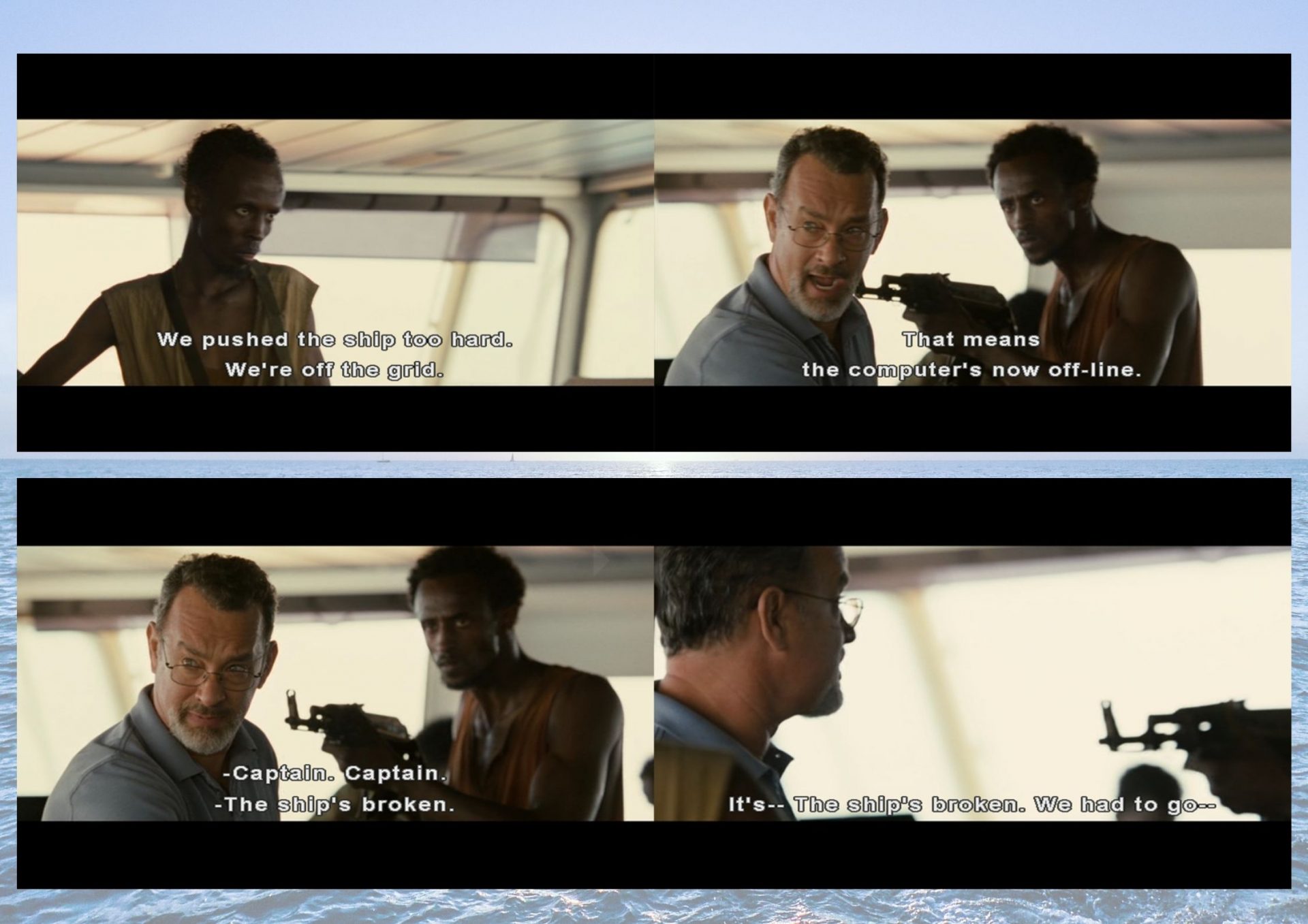
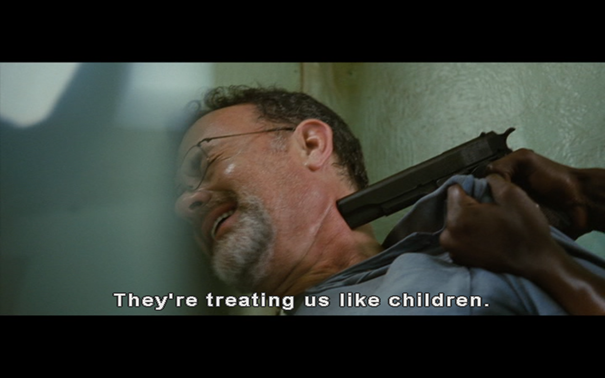
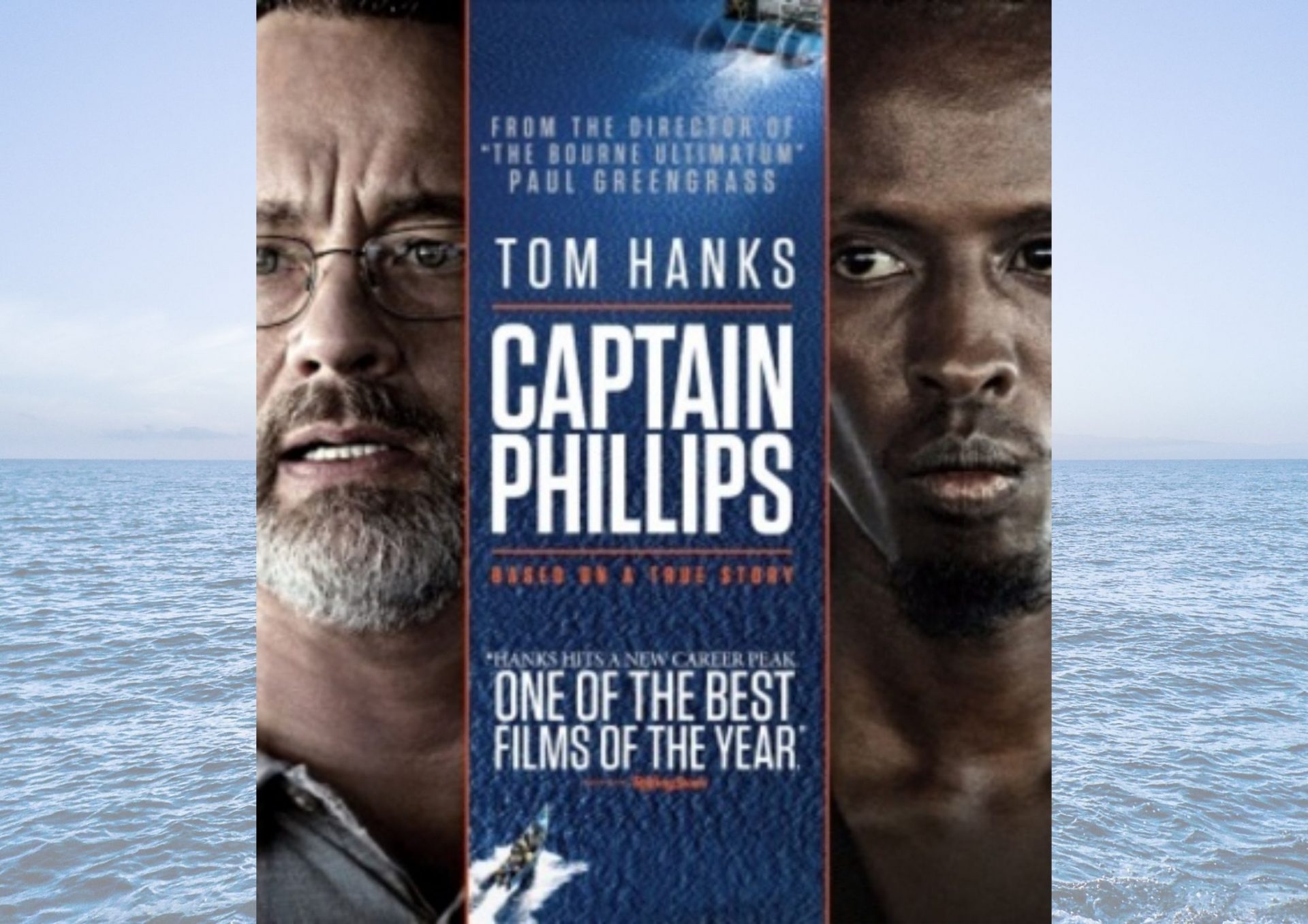
A Tale of Two Captains
This misrepresentation of Somalia in the eyes of the West is epitomised in a comparison of the two Captains that feature in the film and their character development. The film opens with a nuclear family, white-picket fence, American-dream family to introduce American Captain Phillips. Whereas when the film flips to Somali Captain Muse’s opening scene, his life is pictured as poor and mess with him oversleeping in a crumbling shack.
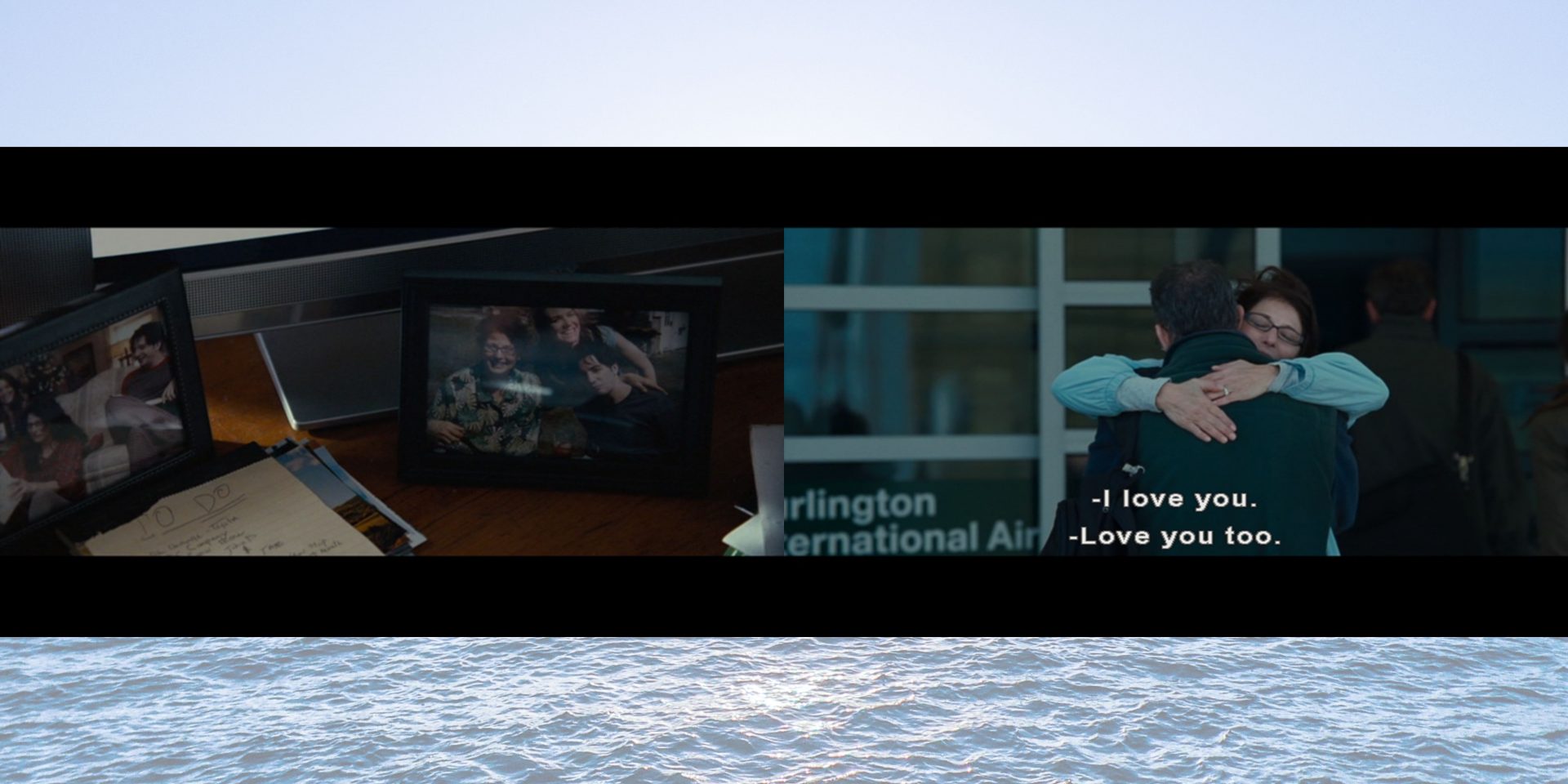
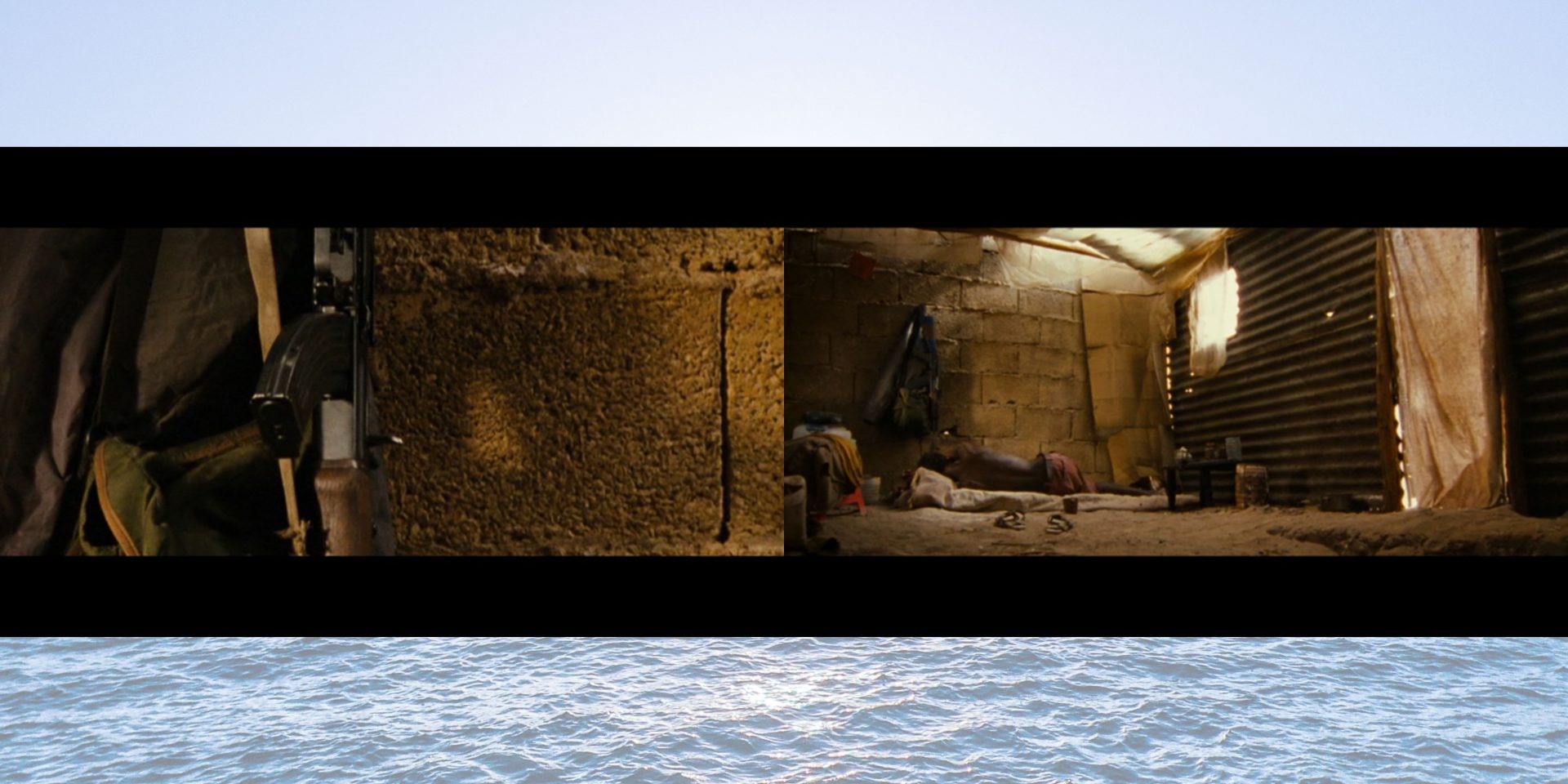
This binary continues through the trajectory of their differing paths throughout the film. Captain Phillips is seen as a hero and selfless throughout the film. From saving his ship and to being congratulated once he was saved, the credits then state that within a few months Captain Phillips was back out on the high seas he is framed as brave and unstoppable. Yet the film fails to mention how in real life, the ship Phillips captained was subsequently sued by 11 of the crew for disregard of their safety (Child 2013). However, with the final scene being extremely emotional and the Captain famously crying out “that’s not my blood”, he is shown in a sympathetic human light as someone who has heroically survived this awful ordeal.
As you can see in the video above as well as in the images below, the Somali Captain Muse follows an opposing discourse. Throughout the film he talks of how after this hijacking he will go to America and buy a car. This belittles his character, to connect the idea of having a car as only achievable in the West. Further later in the film in defence of piracy, he argues to Captain Phillips that this is all they can do to make money, that ‘maybe’ there are other opportunities in America. Finally, as Captain Muse is tricked by the SEALs and chained up, he is ironically informed ‘you’re going to America’. After mentioning Phillips' heroic return to the seas, the film describes Muse’s 33-year sentence in a US prison. Therefore, the opposing trajectory of the film features Philips as a victim and hero, and Muse is represented as a pure criminal with no sympathy or investigation into why he was led to piracy.
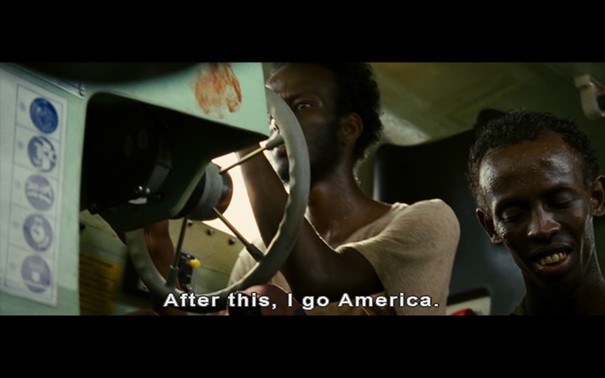
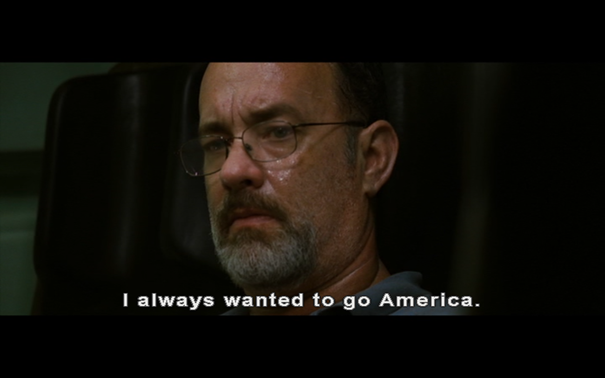
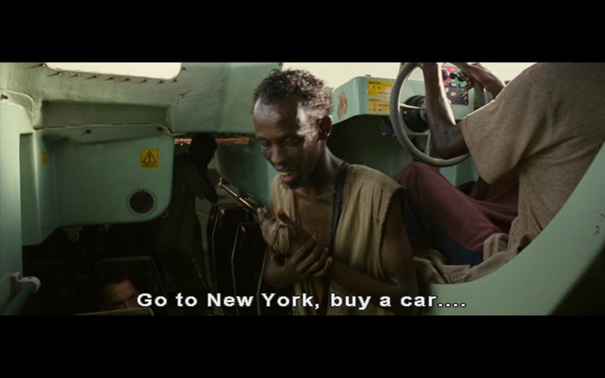
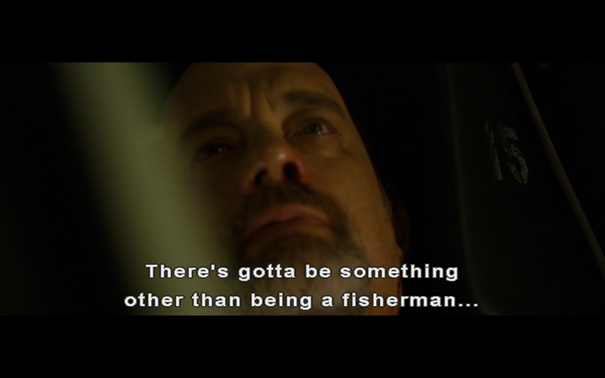
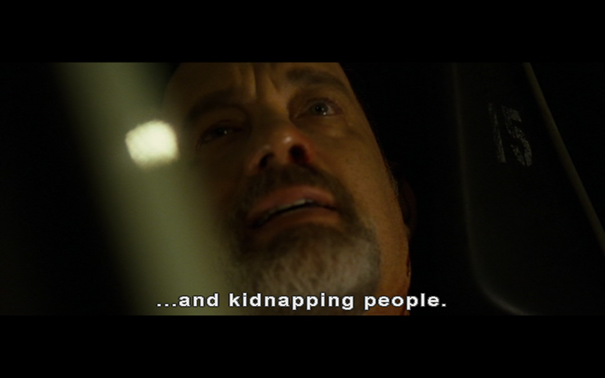
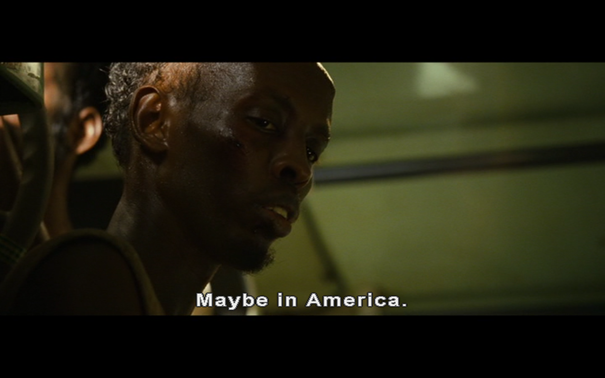
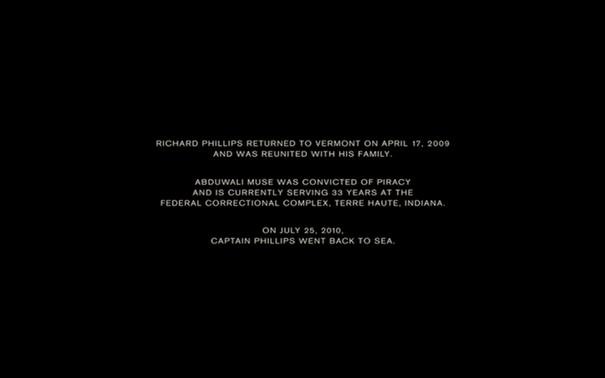
America-Somali relations
The relationship between Somalia and the US is represented within the film as unequal with the dominating all-powerful rich state having the power over Somalia. This quote demonstrates that the Americans are unbeatable and in comparison, to a group of individuals from Somalia, they have unlimited resources and endless opportunities to overpower this group. Yet most telling for the Somali-US relationship is that this all-powerful strong country like the US ‘cannot risk being beaten by Somalis’ due to international repercussions. This suggests even in combat the Somali-US relationship is not equal but rather the shame for the Navy of America to be beaten by a group of Somali pirates is a much greater threat for their reputation and their country in their international sphere, the West, than the pirate attack itself.
Captain Phillips to Captain Muse:
The Navy won’t let you win. They can’t let you win.
This unequal relationship is demonstrated as the Somalis are seen to depend upon the Americans. This is evidenced through the provision of aid and goods that the American ship is holding, at a basic level showcases Somali as a receiver and as reliant on the West to feed ‘the starving people of Africa’. This usage of this grouping within the script demonstrates that these Americans see a group of suffering people with this their main identifier, the aspect of their need. Whilst this notion of rich countries exemplifies how this sits within the larger discussion of the West saving Africa reinforcing the West as dominant and Africa as the dependent. Muse’s reply is critical as it shows the Somalis' awareness of their continual place within the Africa-West relationship as needing to be saved, rather than being seen as equal.
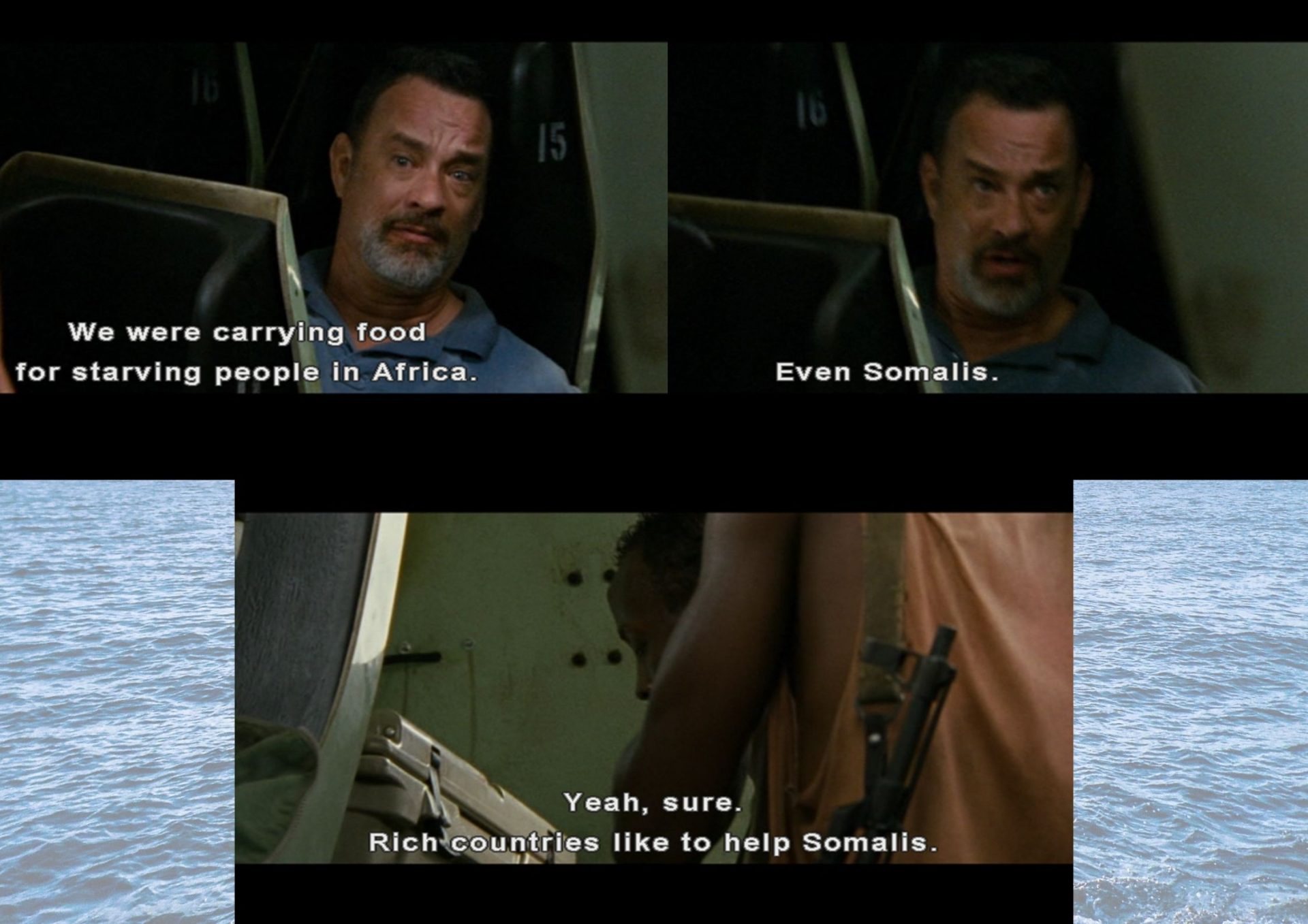
Second Dimension: Discursive Analysis
In considering the production process of the film, this analysis will discuss the novel the film is based on, the backgrounds of the producers as well as their intentions with the film.
Production Process
One of the large differences between the storyline in the book, A Captain's Duty: Somali Pirates, Navy SEALs, and Dangerous Days at Sea, and the film’s storyline, is that (the real-life) Richard Phillips did not go into depth on the backgrounds of the Somali pirates nor their motives (Danoff, 2017). This can be understood as the Captain was abducted by the pirates. However, in his book he strikingly states that the pirates’ reason for the hijack and abduction was not that they could no longer be fishermen due to foreign fishing fleets and toxic-waste dumping, as he contradicts this with his claim;
“I’d seen schools of mackerel, tuna, and other fish every time I’d gone down the coast of Somalia. There was a living to be made out there. I believed the Somalis had simply found easier work: piracy.” (Phillips & Talty, 2010, p.65)
The story on which the film was based focused on the brave Captain Phillips and his rescue by the great American forces rather than exploring the story from other perspectives (Danoff, 2017). In evaluating this as a starting point of the film, we can see that the original narrative is very much written from an American perspective.
The director, Paul Greengrass, indicated that it was one of his major aims of the film to add the Somali perspective. To examine the young Somali men and their environment, and to demonstrate their reasons for becoming pirates (The Guardian, 2013). According to Greengrass, as well as screenwriter Billy Ray, the Somali pirates are living in a hopeless society, where there is only corruption, violence, and poverty; men with nothing to lose (The Guardian, 2013; Film4, 2013; Danoff, 2017). Ray said the following about the Somali Captain Muse:
Muse cannot just wake up in the morning and ... apply for work at a Wal-Mart, because there are just two businesses in Somalia - piracy and the sale of khat [drug]... We're talking about a place with zero economic opportunity, a failed state that has no Navy, no real coast guard and no police. It's a mess, and Muse wakes up every day in the middle of it. I'm not trying to justify piracy, but we needed to open a lens and show viewers what it looks like in Eyl [Somalia], so that you can understand the pirates as human beings. (Danoff, 2017, p.41)
Greengrass confirmed this, expressing his aim not to romanticise pirates, nor demonise them, but rather show the complex reasons for crime (The Guardian, 2013; Film4, 2013). Although he states that his film is “ ultimately is a crime story, it’s a story of a crime and its consequences. The crime is the stealing of a ship and later the kidnap of the captain” (Film4, 2013). Moreover, he stated that he wanted the film to be as authentic and realistic as possible as if it was a documentary. Greengrass believed optimal authenticity is achieved mostly by the correct casting: “it was absolutely imperative that you had Somali actors and it makes a difference, because it makes the entire picture feel authentic.” (Film4, 2013)
The way in which the screenwriter and director talk about Somali pirates, already demonstrates that they have a particular view of Somali pirates and Somalia. Even though they claim that they want to show the story behind the pirates, they merely succeed in a superficial portrayal of Somalia as poor, violent, and beyond-saving. They acknowledge the impact that foreign companies have had on the original income of the Somali people - fishing - however, they believe that the pirates are in the wrong because they are still exhibited as criminals. Greengrass’s aims were to show that who the victim and aggressor in crime might not always be clear-cut, that societies in which crimes take place are complex, and therefore the reality of ‘good’ and ‘bad’ is similarly complex and inseparable. Greengrass claimed that “I wanted to show that these were desperate young men with no chance of employment, and that they generally culturally worship America (Banoff, 42)”. Yet in doing so, as he does through Muse’s aspiration of “going to New York, buy a car” (see Dimension 1: A Tale of Two Captains), he generalises and infantilises Muse. Despite the filmmakers’ more neutral and critical aims, his film still showcases Somalia, Africa and the Somalia people in a very generalised and simplified illustration.
Third Dimension: Social Analysis
In this final dimension of using Setiawan’s method, we explore how Captain Phillips and the discourses represented within the film relate to public debates at the time of production and how it fits within political, cultural and economic systems of the milieu. The film hit the box office in 2013, with the rise of piracy within the Western 24hr news culture in the late 2000s/early 2010s, this phenomenon felt like a threat due to its prevalence in Western media (Collins 2012, Way 2013). Yet as seen in Collin’s chart below, piracy was over-exaggerated as a threat by the media (2012, 116), which the film monopolises upon and further exasperates.

Collins (2012), p.116
Beyond this, the film fails to explain the political-economical system in which piracy exists. Whilst there is an ongoing debate over the causes of piracy, there are three main debates. Firstly, piracy exists due to poverty, a lack of state government and as an opportunity to ameliorate life chances (Elmi et al. 2015, 158, Carafono et al. 2009, Lennox 2008, Way 2014). Secondly, piracy exists as a form of defence and protection of resources (Elmi et al. 2015). Thirdly, Samatar et al. claim that ‘resource piracy’ is when piracy occurs in reaction to the often-illegal overfishing and toxic-waste dumping by large commercial boats leading fishermen to turn to piracy (2010, p.1379). Although the film mentions some of these causes, returning to our analysis of the second dimension, the problem is that these causes are brushed over with the criminality of the Somali men as pirates being focused upon by Greengrass’ direction instead.
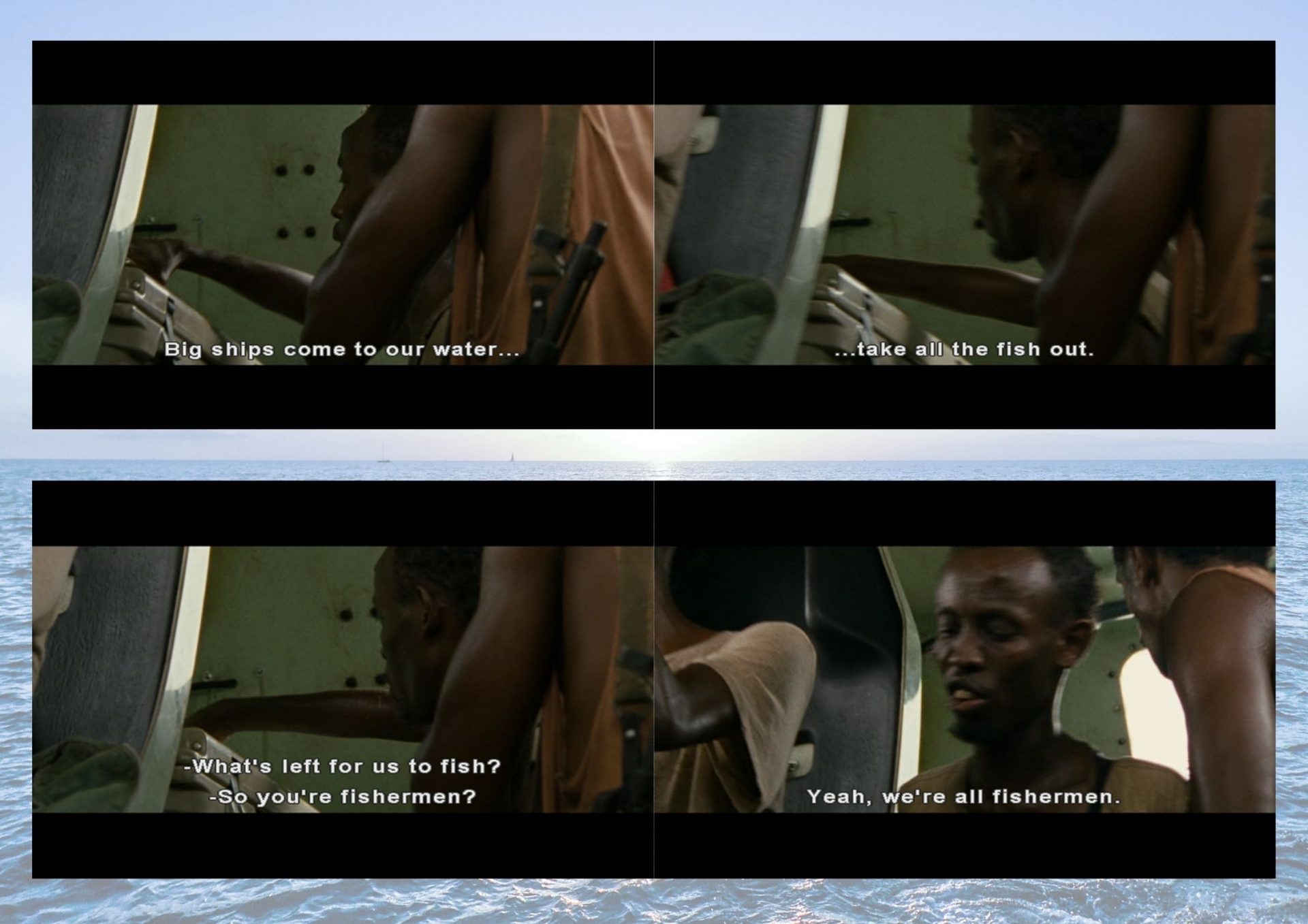
Beyond this public media debate where Somalis with a lack of other incomes turn to piracy are continually viewed as a threat there can be a further investigation of the international capitalist system in which the aforementioned unequal relationship between Somalia and America exists. Somalia at the height of this ‘piracy’ endemic was situated as the perfect example within ‘the failed state discourse’ (Rothe and Collins 2011, and Samatar et al. 2010). A failed state refers to a country with a lack of legal system, government, police, army and bureaucratic institutions (Glück 2011, p.83-88, Samatar et al. 2010, p.1377-8). Without a government, a state cannot enforce taxes internally or externally, and without a ‘monopoly on violence’ and state military, there is no way to enforce protection of maritime areas (Glück 2011, p.83-88) Hence there is a lack of funding for jobs, security and poverty alleviation. Thus when Captain Muse argues that his piracy is for ‘tax’, his act of maritime piracy is in lieu of government support. Although it must be noted that the ‘failed state discourse’ is highly problematic as it is seen to constrain society to a Westphalian ideal and a Western conception of government and state (Hagmann and Hoehne 2009, Hill 2005). However this does explain the Western-dominated discourse and audience which the film both appeals to and contributes to.
Captain Muse to Captain Phillips:
Irish, it’s taxes. This money, taking you, that’s all it is. You come to our waters, you got to pay
From the perspective of the failed state discourse, one can argue that without a government, states cannot protect their waters or punish foreign states who vandalise their land/sea. Therefore as Bueger notes, ‘pirates’ replace states in protecting against toxic-waste dumping, overfishing and invasion of maritime borders (2013). Hence the Somali men in the film fight against the exploitation of the vulnerable condition of Somalia at the time through piracy - which is framed in the West as criminal - without exploring how the West contributes to Somalia’s vulnerability. It could be further argued that, following a World Systems view (Wallerstein 1974), states at the core of the world’s economy, such as those of the rich West including the US, extract and maintain their core position in the international system through their exploitation of Somalia, a peripheral state in the international capitalist economy. In other words, due to the international capitalist system, the US profits from Somalia’s state of ruin through illegal overfishing and toxic waste dumping, so for Somali people, piracy is a form of agency and taxes used in order to avoid destitution as they have no strong government to fight for them.
Yet in Captain Phillips we simply see aggressive pirates and heroic strong Americans under threat.
In conclusion, the film presents a simplification of the true political and economic milieu in which Somalis were living at the time. Through focusing on the heroism of America it dehumanises, misrepresents and criminalises the struggle of the Somali people as violent and poor ‘pirates’, and continues a narrative where Somalis are both reliant upon and dominated by the West.

To conclude, through the first dimension of our analysis we found that Captain Phillips generalised the Somali men as poor and violent and further generalised and simplified the difference between Somalia and America as contrasting opposites. Further, the film was written from an American perspective building upon the American-centric biography it was based upon. Whilst Greengrass indicated his aim to create a multi-layered film by highlighting the Somali side of the story; we found in the first dimension that in his attempt to do this he created a simplified, infantilised and criminalised version of the dilemma of Captain Muse and his crew’s struggle in comparison to a heroic view of Captain Phillips and the US. Beyond this in the third dimension, the film contributes and is situated within the Western discourse a ‘failed state’, wherein Somalia is seen and generalised as an anarchic state, and Somali people as violent, poor and dependent on the West. We can see these three dimensions interact in this generalisation of Somalia throughout Captain Phillips. This substantiated our argument that Somalia and its people are misrepresented in the film, and simplified as criminals coming from a failed state. With our critical discourse analysis we revealed that this film as well as the discourse in which the film is situated fails to understand the unequal power relations at play, wherein the West/US’s exploitation of Somalia can be seen as one of the reasons that Somali people resort to piracy.
This research is important as it highlights the need for the West, the aimed audience of these blockbuster films, to question and investigate these misrepresentations of African peoples and their states within these films. Furthermore, it highlights the need to explore how these misrepresentations influence the West’s consumption of media and 24hr news, and in turn influences our conception of ‘Somalia’, ‘Somali people’ and the relationship between the West and Africa. Due to research limitations, there is more scope to explore within this field, from potential to explore the consumption process of Captain Phillips. For instance, through engaging with the audience’s views, cast interviews, film reviews, and a psychological investigation to understand how this film influences people’s perception of Somalia and piracy. Moreover, through examining how the 24hr news corporations capitalised on this film in their coverage of piracy in the Horn of Africa.
Captain Phillips attempts to be diverse in its perception of an example of Somali piracy, yet hits the rocks, sinking down with misrepresentations and generalisations of Somali people. Which other of your favourite Hollywood films are awash with similar problematic discourse? Can you stop those power dynamics presented within the discourse from anchoring into public discussion and opinion? Comment these films below! Start the conversation with your friends soon.

Bueger C. (2013). Practice, Pirates and Coast Guards: the grand narrative of Somali piracy, Third World Quarterly, 34(10), 1811-1827.
Captain Phillips. (2013, October 24). Marineschepen.nl. Retrieved December 22, 2021, from https://marineschepen.nl/reviews/captain-phillips.html
Carafano J., Weitz, R., & Andersen, M. (2009). Maritime Security: Fighting Piracy in the Gulf of Aden and Beyond. Heritage Foundation.
Chen, S. A. (2013). Captain Phillips. Common Sense Media. https://www.commonsensemedia.org/movie-reviews/captain-phillips
Child, B. (2013, October 14). Captain Phillips ‘no hero’ in real life, say ship’s crew. The Guardian. https://www.theguardian.com/film/2013/oct/14/captain-phillips-tom-hanks-real-life-no-hero
Chitwood, A. (2013, July 26). 2 Posters for Paul Greengrass’ Somali Pirate Drama CAPTAIN PHILLIPS, Starring Tom Hanks. Collider. https://collider.com/captain-phillips-movie-posters/
Collins, V. E. (2012). Dangerous seas: Moral panic and the Somali pirate. Australian & New Zealand Journal of Criminology, 45(1), 106-132.
Danoff, B. (2017). “I’m the Captain Now”: Power, Justice, and Tragedy in “Benito Cereno” and Captain Phillips. American Political Thought (Chicago, Ill.), 6:1, 30–53.
Elmi, A. A., Affi, L., Knight, W. A. & Mohamed, S. (2015). Piracy in the Horn of Africa Waters: Definitions, History, and Modern Causes. African Security, 8(3), 147-165.
Film4. (2013, October 17). Tom Hanks and Paul Greengrass on Captain Phillips. Film4 Interview Special. [Video]. Youtube. https://www.youtube.com/watch?v=zmfW0ygBkwM&ab_channel=Film4
Flixabout.com. (2017), December 2nd,. Fairclough Critical Discourse Analysis. [Video]. YouTube. https://www.youtube.com/watch?v=3w_5riFCMGA&ab_channel=flixabout.com
Glück, Z. (2011). Maritime Piracy, Capital and Securitization: The Case of Somalia. In Tarrosy, I., Szabo, L., & Hyden, G. The African State in a Changing Global Context: Breakdowns and Transformations. (pp.83-100). LIT Verlag.
Greengrass, P. (2013). Captain Phillips [Film]. Colombia Pictures.
Hagmann, T., & Hoehne, M. V. (2009). Failures of the state failure debate: evidence from the Somali territories. Journal of International Development: The Journal of the Development Studies Association, 21(1), 42-57.
Harcup, T. (2014). A Dictionary of Journalism. OUP Oxford.
Hill, J. (2005). Beyond the Other? A postcolonial critique of the failed state thesis. African Identities, 3:2, 139-154.
Internet Movie Database [IMDb]. (2013). “Captain Phillips.” Accessed on 12-12-2021. https://www.imdb.com/title/tt1535109/
Movieclips. (2017), n.d., Captain Phillips (2013) - You’re Safe Now Scene (10/10). [Video]. Youtube. https://www.youtube.com/watch?v=ng95gpwSjZU&ab_channel=Movieclips
Munday, J. (2016). Discourse and register analysis approaches. In J. Munday,
Introducing translation studies: Theories and applications. (pp. 141-168). Routledge.
Lennox, P. (2008). Contemporary Piracy off the Horn of Africa. Canadian Defence & Foreign Affairs Institute.
Pautz, M. C. (2016). Cops on Film: Hollywood’s Depiction of Law Enforcement in Popular Films, 1984–2014. PS, Political Science & Politics, 49(2), 250–258.
Phillips, R. & Talty, S. (2010). A Captain’s Duty: Somali Pirates, Navy SEALS, and Dangerous Days at Sea. Hyperion.
Rothe, D.L. & Collins, V. E. (2011). Got a band-aid? Political discourse, militarized responses, and the Somalia pirate, Contemporary Justice Review, 14:3, 329-343.
Samatar A.I., Lindberg, M. & Mahayni, B. (2010). The Dialectics of Piracy in Somalia: the rich versus the poor. Third World Quarterly, 31:8, 1377-1394.
Setiawan, H. (2018). Deconstructing Concealed Gayness Text in The Film Negeri van Oranje: Critical Discourse Analysis. Humaniora, 30(1), 39-49.
The Guardian. (2013, October 23). Captain Phillips: director Paul Greengrass on his thriller starring Tom Hanks. [Video]. Youtube. https://www.youtube.com/watch?v=YKJ00tdYxuE&ab_channel=TheGuardian
Burning Questions: Captain Phillips and Ugly Audiences. (2013, September 26). the Film Experience. Retrieved December 20, 2021, from http://thefilmexperience.net/blog/2013/9/26/burning-questions-captain-phillips-and-ugly-audiences.html
Wallerstein, I. (1974). The Modern World System. Vol. 1, Capitalist Agriculture and the Origins of the European World-Economy in the Sixteenth Century. New York Academic Press.
Way, L. (2013). Orientalism in online news: BBC stories of Somali piracy. Journal of African Media Studies, 5(1), 19-33.
Way L. (2014). Discourses on Somali Piracy, Journalism Practice, 8:1, 80-95.

